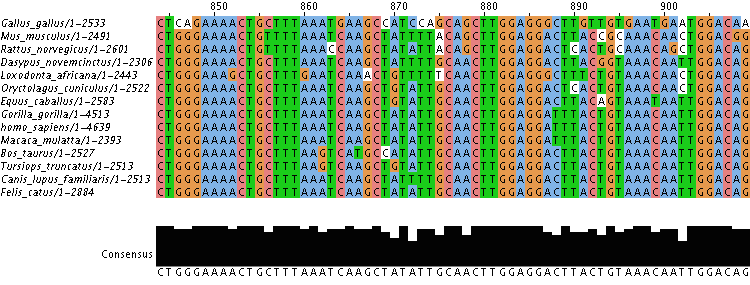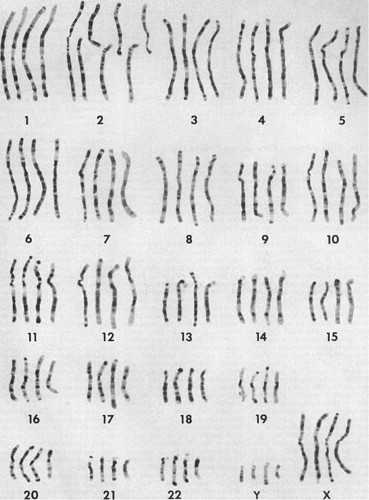Perhaps it is more accurate to say identical twins share the same alleles? That is a question as I am fuzzy on the terminology. Since we have multiple alleles in a population, that accounts for the difference between you and me, but how are different alleles counted when looking at the difference between a chimp and me?
I agree.
Maybe when the chimp genome is finally sequenced, somebody will tell us.
Since an allele is a specific version of DNA, I have no problem with calling shared alleles shared DNA.
They aren’t. Alleles are alternative versions that appear variously in different individuals – the idea is that they can be swapped in for one another. Differences between species aren’t generally considered alleles.
The chimp genome was sequenced in 2005. Not finished, to be sure, but a heck of a lot of it was sequenced, more than enough to give a very good idea of what the differences are between the human and chimp genomes.
And before that, you could mix DNA samples from humans and chimps and see how much of it stuck together. That approach is not sensitive to the variations in copy number. That was the earliest source of a percent difference value. The variations in calculation over time have been misrepresented as an excuse to dismiss the numbers (and those calculating them) in some anti-evolutionary circles.
The “amount of shared DNA” proportions cited for siblings, etc. is often confusing because it ignores the fact that all members of a species have most of the DNA matching. In that context, they are talking about how much of the DNA has the exact same ancestry, ignoring the fact that DNA with slightly different ancestry is mostly the same.
Many bivalves have biparental inheritance of mitochondria, as a complication to the system.
Identical twins are essentially clones. They are genetically identical . . . sort of. There are still somatic mutations early in embryonic development which can produce small differences between twins, perhaps 5 or so mutations if I had to speculate. To put it a different way, identical twins share as much DNA as the cells in your own body share with each other.
Thanks. I know a couple of kids who are twins, and tell them apart by a couple of moles but primarily because the hair swirl on one’s head is clockwise, the other counterclockwise. Sort of cis and trans.
Where it gets confusing for me is the terminology where DNA match is compared, and how it is defined differently between you and me (due to different alleles) and me and monkey. But this has helped with that.
They will have different fingerprints as well. They may start off as two balls of cells with the same DNA, but there is a bit of chaos in the process which can produce different results during embryonic development.
Alleles are different versions of the same gene in the same species. Even this terminology can be confusing at times because it can be defined by either phenotype or DNA sequence. The terminology can also be applied to non-genes.
If we are comparing DNA between species then we use terms like homolog, ortholog, and paralog:
In all cases, we align the sequences and count the places where they differ. Part of that process is determining which chunks of each genome should be aligned to one another, and there are standards and practices that govern those decisions. An alignment between multiple species might look like this:
I like accuracy and precision, but will settle for “fuzzy close enough” when getting accuracy and precision are more difficult than the effort of getting them is worth. I suspect getting accuracy and precision in comparing DNA between species is going to be more difficult for me than the effort is worth.
One fuzzy close enough answer, then, is that human and chimp DNA look as similar as we’d expect if the two species shared a common ancestor 6 or 7 million years ago.
Now that’s an answer that’s somewhat less challenging than believing in a literal, divine creation of Adam out of dust and of Eve out of one of Adam’s ribs. And I figure that that’s about the best answer I’m going to get in my lifetime.
The concept is somewhat simple, but the actual measurements can be difficult. There are previous posts with actual human and chimp sequence, but here is a larger chunk:
Identities: 537/540 (99%)
Gaps: 1/540 (99%)
Query 1 TTGTGTCTGTACACTTTTCCATGTGGCCGGTGTATTTTGTCTCTGGTCATTTGTGCGATC 60
||||||||||||||||||||||||||||||||||||||||||||||||||||||||||||
Sbjct 101 TTGTGTCTGTACACTTTTCCATGTGGCCGGTGTATTTTGTCTCTGGTCATTTGTGCGATC 160
Query 61 CTGGGTGTTTGAGCTTCTCCGTGCTTTACGTCGTGGGCCTGGTTGTGTTTGTGTGCCCGC 120
||||||||||||||||||||||||||||||||||||||||||||||||||||||||||||
Sbjct 161 CTGGGTGTTTGAGCTTCTCCGTGCTTTACGTCGTGGGCCTGGTTGTGTTTGTGTGCCCGC 220
Query 121 GCAGTTATTGTGCCCTTTGTGTCAGGCATATATTGGGCCATGTGGTCTACGACTGCTCCG 180
|||||||||||||||||||||||||||||||||| |||||||||||||||||||||||||
Sbjct 221 GCAGTTATTGTGCCCTTTGTGTCAGGCATATATTTGGCCATGTGGTCTACGACTGCTCCG 280
Query 181 TGTGTGATAAGTCAGAACTTCGTGCATGCCGGGGTGCTCCTCGTGTGCTGAGTGCCTTCT 240
||||||||||||||||||||||||||||||||||||||||||||||||||||||||||||
Sbjct 281 TGTGTGATAAGTCAGAACTTCGTGCATGCCGGGGTGCTCCTCGTGTGCTGAGTGCCTTCT 340
Query 241 CCGTGTGCGCCGCTTGAGTTGGCCGTGGGTCCAAGCGTTGTACTCTGGGCACCCTTTGGG 300
||||||||||||||||||||||||||||||||||||||||||||||||||||||||||||
Sbjct 341 CCGTGTGCGCCGCTTGAGTTGGCCGTGGGTCCAAGCGTTGTACTCTGGGCACCCTTTGGG 400
Query 301 TCTGCCTACTGTTGGAGTTGACACACCACCAAATGAAGTCAGTACACCGGAGAGCTGAGT 360
|||||||||||||||||||||||||| |||||||||||||||||||||||||||||||||
Sbjct 401 TCTGCCTACTGTTGGAGTTGACACACTACCAAATGAAGTCAGTACACCGGAGAGCTGAGT 460
Query 361 CCATGAGGTTTCTCTAGAACCAGCTAGGGGAGGCCCAAGGGTCTGGGAATCTGGAGACCT 420
||||||||||||||||||||||||||||||||||||||||||||||||||||||||||||
Sbjct 461 CCATGAGGTTTCTCTAGAACCAGCTAGGGGAGGCCCAAGGGTCTGGGAATCTGGAGACCT 520
Query 421 GGATTCTAGATCCTGCGGTTTTGAGTGACCTTGGGATGGACGGCTTC-TTCTAAGAATCC 479
||||||||||||||||||||||||||||||||||||||||||||||| ||||||||||||
Sbjct 521 GGATTCTAGATCCTGCGGTTTTGAGTGACCTTGGGATGGACGGCTTCTTTCTAAGAATCC 580
Query 480 GGTTTCTCCTCTGTGAAGTAGATTTGGTAACCCTGGCTCCTGCTGACCTCACGGAGCTGT 539
||||||||||||||||||||||||||||||||||||||||||||||||||||||||||||
Sbjct 581 GGTTTCTCCTCTGTGAAGTAGATTTGGTAACCCTGGCTCCTGCTGACCTCACGGAGCTGT 640
The human sequence is on top and the chimp sequence is on the bottom. They differ in three spots, 2 are base substitutions and one is a single base indel. However you want to measure it, that’s what shared DNA between closely related species looks like.
However I want to measure it, that’s what shared DNA between closely related species looks like, eh? Let’s see …
- I’m told by the best genetic genealogists in the business that modern bona fide, “normal” homo sapiens have four kinds of DNA:
- autosomal DNA (atDNA) inherited from a male parent and a female biological parent, found in 22 of their normal 23 chromosomes;
- X-DNA inherited from a female biological parent, and
- X-DNA inherited from a male biological parent, if they’re female, or Y-DNA inherited from a male biological parent, if they’re male; either of which (X- or Y-DNA) is found in a 23rd chromosome; and
- some quantity of mitochondrial DNA (mtDNA) inherited only from a female biological parent, which is found, not in the nucleus of the human’s cell at any stage in it’s development from zygote until final and complete post-death deterioriation, if that happens.
If you agree, then I ask you: does the modern, normal chimp genome, have all that?
They sure do, except that chimps (and other great apes) have one more pair of chromosomes than humans do. This is due to a chromosome fusion event somewhere along the lineage that gave rise to humans.
Ahhh, … so you want to play, too, cousin? Okay, get in a bumper-car on the bumper-car court, strap on your seat-belt, put on your helmet, and get ready to roll around a bit.
You say that modern chimps have a pair of chromosomes that humans don’t due to some “somewhat nebulous” theoretical “chromosome fusion event somewhere along the lineage that gave rise to humans.”
Sounds kind of precise to me, but does it really mean that modern chimps and homo sapiens “share the same DNA”? Seems to me that if you have 200 euros (EU) and I have 100 dollars (US), you and I both have money, but we don’t share the same money, do we?
I wouldn’t call them “kinds of DNA” since they all have the same exact chemistry. I would describe it as 4 pools of DNA: non-sex chromosomes, Y chromosome, X chromosome, and mitochondria. What differs between them is how they are inherited.
And yes, chimps have all those same pools of DNA. If we venture farther than the primates into the larger mammal and vertebrate group you would see a number of diverse systems for sex chromosomes and determination of sex.
Now you’re quibbling. But I’ll let it slide for now.
So, chimps and homo sapiens have 4 “pools” of chromosomes in common. Cool! But chimps have more non-sex chromosomes than humans, right? And if I understand Dave Carlson’s link, the hypothesized “chromosome fusion event” was the approximate beginning of the “hominid” (?) line, separating humans and great apes.
Good Lord! Cousin, stay on the bumper-car court. Let’s stick to the post-“chromosome fusion event”.
Yes. Two of those chromosomes fused together in the human lineage. We still have the same DNA, but it’s packaged differently.
Whoa! now that’s an impressive visual comparison.
This is what the actual human and chimp chromosomes look like next to each other:
It’s tough to see, but the chromosomal banding patterns in chromosome 2 are what you see in the idealized picture from the previous post. If I understand the process correctly, the banding pattern is caused by dyes that prefer A’s and T’s, so regions rich in AT repeats dye more heavily than other areas.
As examples: calyptraeids (slippersnails, Chinese hats and cup-and-saucers) are sequential hermaphrodites, half-grown individuals are male and full-grown are female. They live in stacks of up to 10 (typically) individuals. Then there are the hexaploid-get-two-copies-of-their nuclear-DNA-from-their-mother-and-one-from-their-father organisms, the females-inherit-mother’s-mitochondria-and-males-inherit-father’s, and the massively polyploid sphaeriids (~20x-200x) and ferns (>1000x). There are stranger numbers in certain hybrids, like pentaploid and heptaploid.


